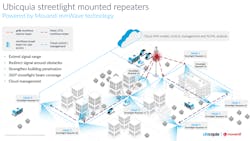Ubicquia, Movandi Team on mmWave 5G Streetlight Repeaters
The Overview
A strategic partnership between Ubicquia, a maker of intelligent infrastructure platforms, and Movandi, which manufactures 5G mmWave RF semiconductors, will result in mmWave smart repeaters that plug into a streetlight’s photocell socket in minutes.
Who Needs It & Why?
Though mmWave 5G provides up to 100X more capacity than 5G mid-band spectrum, propagation distance is typically <250 meters and mmWaves don't turn corners or get inside buildings very well. Network operators have already spent $4.5 billion to acquire mmWave spectrum. Now, in addition, if mmWave 5G is to deliver on its promise of pervasive gigabit-per-second throughputs in the face of booming demand, network operators must rapidly expand their infrastructure while keeping cost of ownership under control.
Such infrastructure expansion means that network operators need a readily available vehicle so that small cells can give their mmWave 5G networks enough sites to handle the capacity requirements. In urban settings as well as in less populated areas, existing streetlights could be the answer to the looming issue of deployment economics.
Under the Hood
Ubicquia's mmWave streetlight repeater uses existing streetlights and their persistent power, 50-meter spacing, and 8- to 10-meter heights to make millions of site-ready locations available at a fraction of the time and money spent building new poles for 5G radio base stations (gNBs) and pulling fiber to them (see figure).
The repeaters install in minutes, are barely visible at street level, and are configured and managed in the cloud to turn deployments into a single trip to the pole. They meet utility power, protection, metering, weight, and wind-loading requirements.
The repeaters ensure optimal outdoor coverage and user experiences by extending the range of 5G mmWave gNBs and redirecting its signals around obstacles. They lock onto host RAN (radio access network) signals automatically to ensure repeater-to-repeater connectivity without the need for fiber connectivity to the core network. On top of that, they integrate with all major RAN/Open RAN technologies, including Ericsson, Huawei, Nokia, and Samsung, and support all global mmWave spectrum bands.
Movandi comes into the picture with its mmWave 5G RF technology and reference design platforms. Its offerings range from RF semiconductors and custom phased-array antenna modules to algorithms and software including cloud APIs for management, control, and AI/ML data analytics.
On the fronts of speeding mmWave 5G deployment and lowering cost of ownership, Joe Madden, principal analyst at Mobile Experts, asserts that “streetlight-mounted repeaters present an incredible opportunity to dramatically speed up deployment schedules, streamline many regulatory and installation approval steps, and save money.”
He adds, “In our assessment of a small city requiring 950 new 5G mmWave radio base stations [gNBs] for full coverage, we found that using 100 streetlight-mounted gNBs and 850 repeaters reduces 10-year total cost of ownership by over $13 million or 35%, and by $89 million or 80% compared to a gNB-only utility-pole configuration. Our conclusion is that streetlight deployment is absolutely the way to go.”
About the Author
David Maliniak
Executive Editor, Microwaves & RF
I am Executive Editor of Microwaves & RF, an all-digital publication that broadly covers all aspects of wireless communications. More particularly, we're keeping a close eye on technologies in the consumer-oriented 5G, 6G, IoT, M2M, and V2X markets, in which much of the wireless market's growth will occur in this decade and beyond. I work with a great team of editors to provide engineers, developers, and technical managers with interesting and useful articles and videos on a regular basis. Check out our free newsletters to see the latest content.
You can send press releases for new products for possible coverage on the website. I am also interested in receiving contributed articles for publishing on our website. Use our contributor's packet, in which you'll find an article template and lots more useful information on how to properly prepare content for us, and send to me along with a signed release form.
About me:
In his long career in the B2B electronics-industry media, David Maliniak has held editorial roles as both generalist and specialist. As Components Editor and, later, as Editor in Chief of EE Product News, David gained breadth of experience in covering the industry at large. In serving as EDA/Test and Measurement Technology Editor at Electronic Design, he developed deep insight into those complex areas of technology. Most recently, David worked in technical marketing communications at Teledyne LeCroy, leaving to rejoin the EOEM B2B publishing world in January 2020. David earned a B.A. in journalism at New York University.


